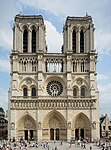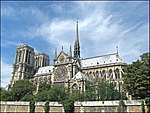Notre-Dame de Paris (French: [nɔtʁə dam də paʁi] (listen); meaning "Our Lady of Paris"), referred to simply as Notre-Dame, is a medieval Catholic cathedral on the Île de la Cité (an island in the Seine River), in the 4th arrondissement of Paris. The cathedral, dedicated to the Virgin Mary, is considered one of the finest examples of French Gothic architecture. Several of its attributes set it apart from the earlier Romanesque style, particularly its pioneering use of the rib vault and flying buttress, its enormous and colourful rose windows, and the naturalism and abundance of its sculptural decoration. Notre Dame also stands out for its musical components, notably its three pipe organs (one of which is historic) and its immense church bells.Construction of the cathedral began in 1163 under Bishop Maurice de Sully and was largely completed by 1260, though it was modified frequently in the centuries that followed. In the 1790s, during the French Revolution, Notre-Dame suffered extensive desecration; much of its religious imagery was damaged or destroyed. In the 19th century, the coronation of Napoleon I and the funerals of many of the French Republic's presidents took place at the cathedral.
The 1831 publication of Victor Hugo's novel Notre-Dame de Paris (known in English as The Hunchback of Notre-Dame) inspired popular interest in the cathedral, which led to a major restoration project between 1844 and 1864, supervised by Eugène Viollet-le-Duc. During World War II, after the Allies' 1944 victory in Europe, the liberation of Paris was celebrated in Notre-Dame with the singing of the Magnificat. Beginning in 1963, the cathedral's façade was cleaned of centuries of soot and grime. Another cleaning and restoration project was carried out between 1991 and 2000.The cathedral is one of the most widely recognized symbols of the city of Paris and the French nation. In 1805, it was awarded the honorary status of a minor basilica. As the cathedral of the archdiocese of Paris, Notre-Dame contains the cathedra of the archbishop of Paris (Michel Aupetit).
Approximately 12 million people visit Notre-Dame annually, making it the most visited monument in Paris. The cathedral has long been renowned for its Lent sermons, a tradition founded in the 1830s by the Dominican Jean-Baptiste Henri Lacordaire. In recent years, these sermons have increasingly often been given by leading public figures or government-employed academics.
Over time, the cathedral has gradually been stripped of many of its original decorations and artworks. However, the cathedral still contains several noteworthy examples of Gothic, Baroque, and 19th-century sculptures, a number of 17th- and early 18th-century altarpieces, and some of the most important relics in Christendom – including the Crown of Thorns, a sliver of the true cross and a nail from the true cross.
On 15 April 2019, while Notre-Dame was undergoing renovation and restoration, its roof caught fire and burned for about 15 hours. The cathedral sustained serious damage as a result. The flèche (the timber spirelet over the crossing) was destroyed, as was most of the lead-covered wooden roof above the stone vaulted ceiling. This resulted in contamination of the site and the nearby environment with lead. After the fire, many of the proposals for restoration suggested modernizing the cathedral's design, but the French National Assembly rejected this approach, enacting a law on 29 July 2019 that required the restoration to preserve the cathedral's “historic, artistic and architectural interest”. The task of stabilizing the building against possible collapse was completed in November 2020, and reconstruction began in 2021. The government of France has said it hopes the reconstruction can be completed by Spring 2024, in time for the opening of the 2024 Summer Olympics in Paris. President Emmanuel Macron confirmed on 14 April 2021 that the cathedral site will be formally returned to the church on 15 April 2024, and that the first mass since the fire will be held in the cathedral nave on that day, even if the reconstruction has not been finished by then.










